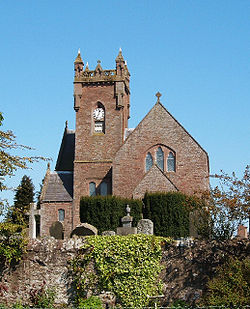Meigle: Difference between revisions
Created page with "{{distinguish|Meigle, Ayrshire}} {{Infobox town |name=Meigle |county=Perthshire |picture=Meigle Parish Church.jpg |picture caption=Meigle parish church |os grid ref= NO287446 ..." |
|||
| (One intermediate revision by one other user not shown) | |||
| Line 9: | Line 9: | ||
|longitude=-3.16182 | |longitude=-3.16182 | ||
|postcode=PH12 | |postcode=PH12 | ||
|post town= | |post town=Blairgowrie | ||
|population= | |population= | ||
|LG district=Perth and Kinross | |LG district=Perth and Kinross | ||
}} | }} | ||
'''Meigle''' is a village in [[Strathmore]], in [[Perthshire]]. The nearest town is [[Forfar]] in neighbouring [[Angus]]. Other smaller settlements nearby are [[Balkeerie]], [[Kirkinch]] and [[Kinloch, Angus|Kinloch]]. | '''Meigle''' is a village and parish in [[Strathmore]], in [[Perthshire]]. The nearest town is [[Forfar]] in neighbouring [[Angus]]. Other smaller settlements nearby are [[Balkeerie]], [[Kirkinch]] and [[Kinloch, Angus|Kinloch]]. The parish and county protrude into Angus to the east such that it is surrounded on three sides by its neighbouring shire. | ||
The name 'Meigle'' is | The name 'Meigle'' is pronounced ''{{IPA|miːɡəl}}'' ('meegl') | ||
The Pictish stones on display at Meigle are a manifestation of the rich early history of the local area. As further testimony to the Pictish era two miles to the east is the village of [[Eassie]] noted for the presence of the Eassie Stone; this carved Pictish stone is dated to the Early Middle Ages.<ref>[http://www.megalithic.co.uk/article.php?sid=17730 C.Michael Hogan, ''Eassie Stone'', The Megalithic Portal, ed. Andy Burnham, Oct. 7, 2007]</ref> | The Pictish stones on display at Meigle are a manifestation of the rich early history of the local area. As further testimony to the Pictish era two miles to the east is the village of [[Eassie]] noted for the presence of the Eassie Stone; this carved Pictish stone is dated to the Early Middle Ages.<ref>[http://www.megalithic.co.uk/article.php?sid=17730 C.Michael Hogan, ''Eassie Stone'', The Megalithic Portal, ed. Andy Burnham, Oct. 7, 2007]</ref> | ||
==About the village== | ==About the village== | ||
The Meigle Sculptured Stone Museum<ref>[http://www.undiscoveredscotland.co.uk/meigle/meiglestones/ Meigle Pictish Stones at Undiscovered Scotland]</ref> is housed in the former Victorian village school. It contains an important collection of more than thirty Pictish Stones, along with some later carvings, dating between the 8th and 10th centuries, many of them superbly carved. This collection is one of the finest of its type in Western Europe. The village was probably the site of an important Early Mediæval Pictish monastery, centred on the present church and churchyard. | The [[Meigle Museum|Meigle Sculptured Stone Museum]]<ref>[http://www.undiscoveredscotland.co.uk/meigle/meiglestones/ Meigle Pictish Stones at Undiscovered Scotland]</ref> is housed in the former Victorian village school. It contains an important collection of more than thirty Pictish Stones, along with some later carvings, dating between the 8th and 10th centuries, many of them superbly carved. This collection is one of the finest of its type in Western Europe. The village was probably the site of an important Early Mediæval Pictish monastery, centred on the present church and churchyard. | ||
[[Belmont Castle]] was built from the 15th century, originally as a residence of the Bishops of Dunkeld, was the residence of Sir Henry Campbell-Bannerman (1836-1908), Prime Minister of the United Kingdom 1905-08. He is buried in the village churchyard. A mural monument to his memory if built into the north-east wall of the church. | [[Belmont Castle]] was built from the 15th century, originally as a residence of the Bishops of Dunkeld, was the residence of Sir Henry Campbell-Bannerman (1836-1908), Prime Minister of the United Kingdom 1905-08. He is buried in the village churchyard. A mural monument to his memory if built into the north-east wall of the church. | ||
Latest revision as of 12:48, 20 April 2022
- Not to be confused with Meigle, Ayrshire
| Meigle | |
| Perthshire | |
|---|---|
 Meigle parish church | |
| Location | |
| Grid reference: | NO287446 |
| Location: | 56°35’18"N, 3°9’43"W |
| Data | |
| Post town: | Blairgowrie |
| Postcode: | PH12 |
| Local Government | |
| Council: | Perth and Kinross |
Meigle is a village and parish in Strathmore, in Perthshire. The nearest town is Forfar in neighbouring Angus. Other smaller settlements nearby are Balkeerie, Kirkinch and Kinloch. The parish and county protrude into Angus to the east such that it is surrounded on three sides by its neighbouring shire.
The name 'Meigle is pronounced miːɡəl ('meegl')
The Pictish stones on display at Meigle are a manifestation of the rich early history of the local area. As further testimony to the Pictish era two miles to the east is the village of Eassie noted for the presence of the Eassie Stone; this carved Pictish stone is dated to the Early Middle Ages.[1]
About the village
The Meigle Sculptured Stone Museum[2] is housed in the former Victorian village school. It contains an important collection of more than thirty Pictish Stones, along with some later carvings, dating between the 8th and 10th centuries, many of them superbly carved. This collection is one of the finest of its type in Western Europe. The village was probably the site of an important Early Mediæval Pictish monastery, centred on the present church and churchyard.
Belmont Castle was built from the 15th century, originally as a residence of the Bishops of Dunkeld, was the residence of Sir Henry Campbell-Bannerman (1836-1908), Prime Minister of the United Kingdom 1905-08. He is buried in the village churchyard. A mural monument to his memory if built into the north-east wall of the church.
Sport
- Cricket: Meigle Cricket Club
Outside links
| ("Wikimedia Commons" has material about Meigle) |
